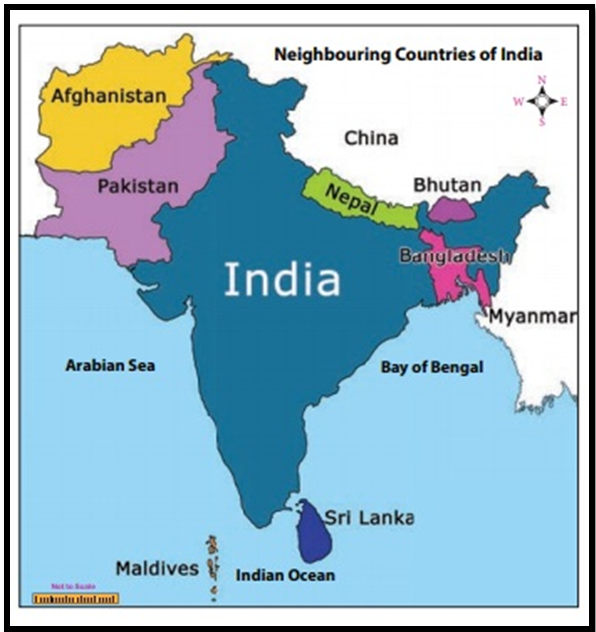NEIGHBOURHOOD FIRST POLICY: CHALLENGES AND DYNAMICS
Syllabus:
- GS-2- International relations and India , Neighbourhood First policy and its implications for India and the World.
Focus :
- The article examines India’s “Neighbourhood First” policy, focusing on its objectives, achievements, and challenges. It highlights the policy’s impact on relationships with South Asian neighbours, emphasizing economic integration, security cooperation, and infrastructure development. The analysis includes strategic measures, case studies, and recommendations for enhancing regional cooperation and sustainable development.
Source - TET
Introduction
- Strategic Significance: India’s “Neighbourhood First” policy aims to enhance ties with South Asian neighbors, emphasizing cooperation and mutual benefits.
- Policy Genesis: Initiated by Prime Minister Narendra Modi in 2014, it underscores India’s commitment to regional stability and prosperity.
- Geographical Scope: The policy primarily focuses on countries like Bhutan, Nepal, Bangladesh, Sri Lanka, and the Maldives.
- Historical Context: Historically, India has had complex relationships with its neighbors, marked by both cooperation and conflict.
Key Objectives of the Policy
- Economic Integration: Enhance trade and economic ties through various agreements and partnerships.
- Security Cooperation: Address shared security challenges, including terrorism and transnational crimes.
- Infrastructure Development: Collaborate on infrastructure projects to boost connectivity.
- Cultural and Social Bonds: Strengthen people-to-people ties through cultural exchanges and educational initiatives.
- Environmental Cooperation: Address environmental issues like climate change and disaster management collectively.
Achievements and Progress
- Improved Bilateral Relations: Significant improvements in relations with countries like Bhutan, Bangladesh, and the Maldives.
- Trade Agreements: Signing of various trade agreements, enhancing economic interdependence.
- Infrastructure Projects: Initiation of key infrastructure projects like roadways, railways, and ports.
- Cultural Exchanges: Increased cultural exchanges and educational scholarships fostering goodwill.
- Security Collaboration: Enhanced security collaboration, including joint military exercises and intelligence sharing.
Challenges and Obstacles
- Political Instability: Political instability in neighboring countries often hampers policy implementation.
- Economic Disparities: Significant economic disparities among South Asian countries pose challenges to uniform development.
- Territorial Disputes: Ongoing territorial disputes, notably with Pakistan and China, complicate regional dynamics.
- Influence of External Powers: Growing influence of external powers like China in South Asia impacts India’s strategic interests.
- Resource Constraints: Limited financial and technological resources restrict the scope and speed of developmental projects.
Specific Regional Issues
- Pakistan: Persistent tension over territorial disputes and cross-border terrorism.
- Nepal: Strains due to border issues and political differences, impacting bilateral cooperation.
- Sri Lanka: Ethnic tensions and influence of external powers, particularly China.
- Bangladesh: Issues related to illegal immigration and river water sharing.
- Maldives: Political volatility and strategic competition with China.
Policy Implementation Strategies
- Diplomatic Engagement: Increased high-level diplomatic engagements and state visits.
- Economic Incentives: Offering economic incentives and aid packages to foster cooperation.
- Multilateral Forums: Leveraging multilateral forums like SAARC and BIMSTEC for regional cooperation.
- Public Diplomacy: Enhancing public diplomacy to build a positive perception of India.
- Infrastructure Investment: Prioritizing investment in cross-border infrastructure projects.
Case Studies and Examples
- Bhutan: Hydropower cooperation, resulting in significant economic benefits for both countries.
- Bangladesh: Successful resolution of the land boundary dispute and enhanced trade relations.
- Sri Lanka: Collaboration on port development projects and counter-terrorism efforts.
- Nepal: Mixed outcomes due to political and territorial tensions but ongoing efforts for economic cooperation.
- Maldives: Strategic cooperation on maritime security and infrastructure development.
Future Prospects and Recommendations
- Enhanced Regional Integration: Fostering deeper regional integration through consistent policy efforts.
- Conflict Resolution: Prioritizing conflict resolution and peace-building measures.
- Sustainable Development: Focusing on sustainable development projects addressing regional challenges.
- Inclusive Growth: Ensuring inclusive growth that benefits all sections of society in the region.
- Strengthening Institutions: Strengthening regional institutions to support sustained cooperation.
Source:The Economic Times
Associated Article :
Mains Practice Question :
GS-2
“Discuss the key objectives and challenges of India’s “Neighbourhood First” policy. How has this policy impacted India’s relations with its South Asian neighbors? Provide relevant examples.”(250 words)




